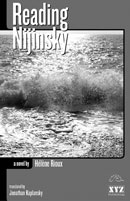
Reading Nijinsky
Helene Rioux
XYZ Publishing
$17.95
paper
176pp
0-9688166-5-7
“When I was translating, I often felt like slipping non sequiturs into the text,” confesses our heroine Éléonore. “Writing ‘his flabby thighs’ instead of ‘his firm thighs,’ talking about the hero’s ‘fairy looks’ instead of his ‘fiery looks.'” But Éléonore slips a seeming non sequitur into her own life instead, hopping the Atlantic to Almuñecar, Spain in order to translate the autobiography of Leonard Ming, a sadistic serial killer. This leap is not wholly without reason, however. The translation of the horrifying text becomes a compulsive self-test for Éléonore, but more significantly, a substitute for the missing truth around the mysterious death of her own daughter.
Hélène Rioux has set for herself a challenge as deadly as that of her protagonist: to comprehend from behind the veil of art the reality of atrocity. In this sensibly and sensitively constructed novel, Rioux nearly completely succeeds. She avoids a melodramatic or sensational handling of the repulsive subject matter with the well-paced inclusion of tranquil, lyrical passages, often detailing the continuity of the Andalusian way of life or of nature. These contemplative reprieves facilitate a receptive and critical reading overall. Some passages remain unbearably unpalatable, but their context at least offers strategies for reading the unreadable, for translating the untranslatable.
In Reading Nijinsky, translation becomes one process for approaching atrocity. A translation never exactly duplicates the meaning of the original, just as no monument, no account of atrocity, no matter how sympathetic, can make a victim’s experience overflow into that of another. Yet these approximations or substitutions are the necessary vehicle of understanding. If Éléonore has a tragic flaw, it is an excess of compassion, which compels her to seek obsessively an absolute translation of victims’ feelings and experiences. She engages in a disturbed game in order to enter what she terms “death and its truth.” Indirectly, this novel exposes the dangers of believing in perfect translations of any sort.
Reading Nijinsky treats translation as much as it treats genre, as Éléonore makes the transition from the Love Collection to the True Crimes Collection. Genre writing appears to have infected the spirits of several of Ms. Rioux’s characters, which may account for some of their outrageous dialogue. Early in the novel, Éléonore meets Lukas in circumstances so coincidental that they could only happen in a romance novel, or in the deconstruction of one. Having overheard part of an intimate conversation between Éléonore and her seatmate on the plane to Madrid, Lukas runs into Éléonore in Almuñecar, where he is having a house built. Although the opening situation allows for an ironic unravelling of the romance genre later on, this rambling conversation unloads a lot of expository information while developing a character who does not appear again. This character, a reader of Éléonore’s translations, talks about her fantasies in what seems to be an imaginary conversation. The reader-translator meeting is an interesting idea, but a shorter version set off as a preface may have functioned better.
Nijinksy wrote, “She does not think of death, because she does not want to die. I think of death, because I do not want to die.” Reading Nijinsky is recommended for those who think like he. mRb






0 Comments